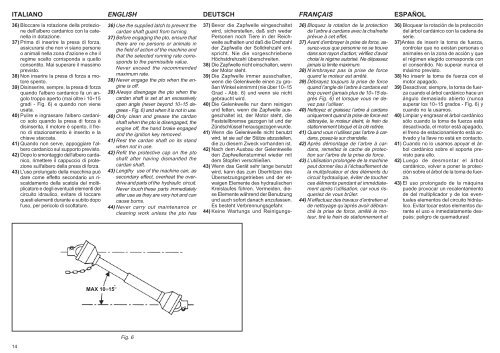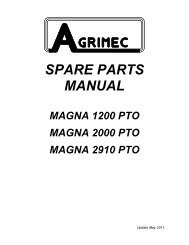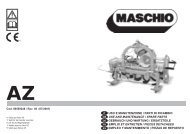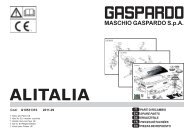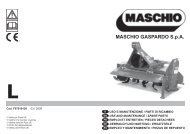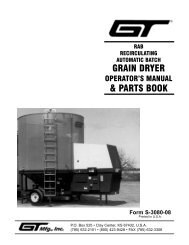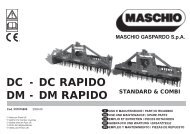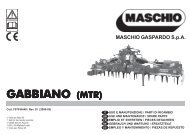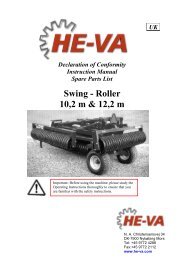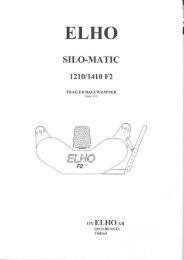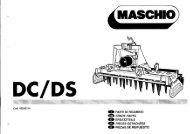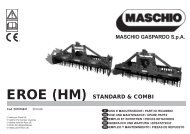uso e manutenzione / parti di ricambio use and maintenance ... - Opico
uso e manutenzione / parti di ricambio use and maintenance ... - Opico
uso e manutenzione / parti di ricambio use and maintenance ... - Opico
You also want an ePaper? Increase the reach of your titles
YUMPU automatically turns print PDFs into web optimized ePapers that Google loves.
ITALIANO ENGLISH DEUTSCH FRANÇAIS<br />
ESPAÑOL<br />
36) Bloccare la rotazione della protezione<br />
dell'albero cardanico con la catenella<br />
in dotazione.<br />
37) Prima <strong>di</strong> inserire la presa <strong>di</strong> forza,<br />
assicurarsi che non vi siano persone<br />
o animali nella zona d'azione e che il<br />
regime scelto corrisponda a quello<br />
consentito. Mai superare il massimo<br />
previsto.<br />
38) Non inserire la presa <strong>di</strong> forza a motore<br />
spento.<br />
39) Disinserire, sempre, la presa <strong>di</strong> forza<br />
qu<strong>and</strong>o l'albero cardanico fa un angolo<br />
troppo aperto (mai oltre i 10÷15<br />
gra<strong>di</strong> - Fig. 6) e qu<strong>and</strong>o non viene<br />
usata.<br />
40) Pulire e ingrassare l'albero cardanico<br />
solo qu<strong>and</strong>o la presa <strong>di</strong> forza è<br />
<strong>di</strong>sinserita, il motore è spento, il freno<br />
<strong>di</strong> stazionamento è inserito e la<br />
chiave staccata.<br />
41) Qu<strong>and</strong>o non serve, appoggiare l'albero<br />
cardanico sul supporto previsto.<br />
42) Dopo lo smontaggio dell'albero cardanico,<br />
rimettere il cappuccio <strong>di</strong> protezione<br />
sull'albero della presa <strong>di</strong> forza.<br />
43) L'<strong>uso</strong> prolungato della macchina può<br />
dare come effetto secondario un riscaldamento<br />
della scatola del moltiplicatore<br />
e degli eventuali elementi del<br />
circuito idraulico, evitare <strong>di</strong> toccare<br />
questi elementi durante e subito dopo<br />
l'<strong>uso</strong>, per pericolo <strong>di</strong> scottature.<br />
14<br />
MAX 10÷15°<br />
36) Use the supplied latch to prevent the<br />
cardan shaft guard from turning.<br />
37) Before engaging the pto, ensure that<br />
there are no persons or animals in<br />
the field of action of the machine <strong>and</strong><br />
that the selected running rate corresponds<br />
to the permissible value.<br />
Never exceed the recommended<br />
maximum rate.<br />
38) Never engage the pto when the engine<br />
is off.<br />
39) Always <strong>di</strong>sengage the pto when the<br />
cardan shaft is set at an excessively<br />
open angle (never beyond 10÷15 degrees<br />
- Fig. 6) <strong>and</strong> when it is not in <strong>use</strong>.<br />
40) Only clean <strong>and</strong> grease the cardan<br />
shaft when the pto is <strong>di</strong>sengaged, the<br />
engine off, the h<strong>and</strong> brake engaged<br />
<strong>and</strong> the ignition key removed.<br />
41) Rest the cardan shaft on its st<strong>and</strong><br />
when not in <strong>use</strong>.<br />
42) Refit the protective cap on the pto<br />
shaft after having <strong>di</strong>smantled the<br />
cardan shaft.<br />
43) Lengthy <strong>use</strong> of the machine can, as<br />
secondary effect, overheat the overdrive<br />
<strong>and</strong> parts of the hydraulic circuit.<br />
Never touch these parts imme<strong>di</strong>ately<br />
after <strong>use</strong> as they are very hot <strong>and</strong> can<br />
ca<strong>use</strong> burns.<br />
44) Never carry out <strong>maintenance</strong> or<br />
cleaning work unless the pto has<br />
Fig. 6<br />
37) Bevor <strong>di</strong>e Zapfwelle eingeschaltet<br />
wird, sicherstellen, daß sich weder<br />
Personen noch Tiere in der Reichweite<br />
aufhalten und daß <strong>di</strong>e Drehzahl<br />
der Zapfwelle der Solldrehzahl entspricht.<br />
Nie <strong>di</strong>e vorgeschriebene<br />
Höchstdrehzahl überschreiten.<br />
38) Die Zapfwelle nicht einschalten, wenn<br />
der Motor steht.<br />
39) Die Zapfwelle immer ausschalten,<br />
wenn <strong>di</strong>e Gelenkwelle einen zu großen<br />
Winkel einnimmt (nie über 10÷15<br />
Grad - Abb. 6) und wenn sie nicht<br />
gebraucht wird.<br />
40) Die Gelenkwelle nur dann reinigen<br />
und fetten, wenn <strong>di</strong>e Zapfwelle ausgeschaltet<br />
ist, der Motor steht, <strong>di</strong>e<br />
Feststellbremse gezogen ist und der<br />
Zündschlüssel herausgezogen wurde.<br />
41) Wenn <strong>di</strong>e Gelenkwelle nicht benutzt<br />
wird, ist sie auf der Stütze abzustellen,<br />
<strong>di</strong>e zu <strong>di</strong>esem Zweck vorh<strong>and</strong>en ist.<br />
42) Nach dem Ausbau der Gelenkwelle<br />
den Zapfwellenstummel wieder mit<br />
dem Stopfen verschließen.<br />
43) Wenn das Gerät sehr lange benutzt<br />
wird, kann das zum Überhitzen des<br />
Übersetzungsgetriebes und der etwaigen<br />
Elemente des hydraulischen<br />
Kreislaufes führen. Vermeiden, <strong>di</strong>ese<br />
Elemente während der Benutzung<br />
und auch sofort danach anzufassen.<br />
Es besteht Verbrennungsgefahr.<br />
44) Keine Wartungs und Reinigungs-<br />
36) Bloquez la rotation de la protection<br />
de l’arbre à cardans avec la chaînette<br />
prévue à cet effet.<br />
37) Avant d’embrayer la prise de force, assurez-vous<br />
que personne ne se trouve<br />
dans son rayon d’action; vérifiez d’avoir<br />
choisi le régime autorisé. Ne dépassez<br />
jamais la limite maximum.<br />
38) N’embrayez pas la prise de force<br />
qu<strong>and</strong> le moteur est arrêté.<br />
39) Débrayez toujours la prise de force<br />
qu<strong>and</strong> l’angle de l’arbre à cardans est<br />
trop ouvert (jamais plus de 10÷15 degrés<br />
Fig. 6) et lorsque vous ne devez<br />
pas l’utiliser.<br />
40) Nettoyez et graissez l’arbre à cardans<br />
uniquement qu<strong>and</strong> la prise de force est<br />
débrayée, le moteur éteint, le frein de<br />
stationnement bloqué et la clé retirée.<br />
41) Qu<strong>and</strong> vous n’utilisez pas l’arbre à cardans,<br />
posez-le sur ch<strong>and</strong>elle.<br />
42) Après démontage de l’arbre à cardans,<br />
remettez le cache de protection<br />
sur l’arbre de la prise de force.<br />
43) L’utilisation prolongée de la machine<br />
peut donner lieu à l’échauffement de<br />
la multiplicateur et des éléments du<br />
circuit hydraulique, éviter de toucher<br />
ces éléments pendant et immé<strong>di</strong>atement<br />
après l’utilisation, car vous risqueriez<br />
de vous brûler.<br />
44) N’effectuez des travaux d’entretien et<br />
de nettoyage qu’après avoir débranché<br />
la prise de force, arrêté le moteur,<br />
tiré le frein de stationnement et<br />
36) Bloquear la rotación de la protección<br />
del árbol cardánico con la cadena de<br />
serie.<br />
37)Antes de inserir la toma de fuerza,<br />
controlar que no existan personas o<br />
animales en la zona de acción y que<br />
el régimen elegido corresponda con<br />
el consentido. No superar nunca el<br />
máximo previsto.<br />
38) No inserir la toma de fuerza con el<br />
motor apagado.<br />
39) Desactivar, siempre, la toma de fuerza<br />
cu<strong>and</strong>o el árbol cardánico hace un<br />
ángulo demasiado abierto (nunca<br />
superar los 10÷15 grados - Fig. 6) y<br />
cu<strong>and</strong>o no la usamos.<br />
40) Limpiar y engrasar el árbol cardánico<br />
sólo cu<strong>and</strong>o la toma de fuerza está<br />
desactivada, el motor está apagado,<br />
el freno de estacionamiento está activado<br />
y la llave no está en contacto.<br />
41) Cu<strong>and</strong>o no lo usamos apoyar el árbol<br />
cardánico sobre el soporte previsto<br />
para ello.<br />
42) Luego de desmontar el árbol<br />
cardánico, volver a poner la protección<br />
sobre el árbol de la toma de fuerza.<br />
43) El <strong>uso</strong> prolongado de la máquina<br />
puede provocar un recalentamiento<br />
de del multiplicador y de los eventuales<br />
elementos del circuito hidráulico.<br />
Evitar tocar estos elementos durante<br />
el <strong>uso</strong> e inme<strong>di</strong>atamente después:<br />
peligro de quemaduras!


